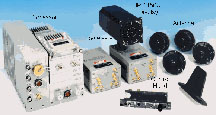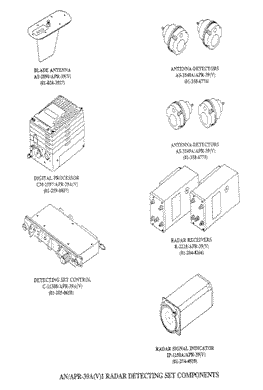





The AN/APR-39A(V)2 is a multi-service (Navy/USMC, Army and Special Operations Force) next generation RWR upgrade to the existing AN/APR-39A. It has human engineering features similar to the AN/APR-39A(V)1 and has added design capabilities to better meet its mission requirements. The system is intended for helicopters and other non-high performance aircraft [AH-1W (USMC), UH-1N (USMC), V-22 (USMC/USN), CH-46 (USMC), CH-53 (USMC), KC-130 (USMC)]. It is capable of detecting and providing alerts to the aircrew of SAM and antiaircraft artillery (AAA) associated pulse, pulse Doppler, and continuous wave (CW) radar activities, identified from a software programmable threat library. This system has much greater threat capability than the AN/APR-39A(V)1 RDS. It is programmed in ADA and offers more flexibility in reprogramming. In addition to the cockpit video display, the APR-39A(v)2 provides the aircrew with synthetic speech audio threat warnings facilitating a "hands on/heads up" aircrew posture. The system also operates as the electronic warfare controller which can integrate and display data from an onboard missile warning system, laser warning system, and expendable countermeasures dispenser. The system retained the former AN/APR-39A low band vertically polarized blade antenna. The new, more sensitive, circularly polarized spiral antennae are a form and fit replacement for the previous equipment, as is the new night vision compatible cockpit video display and the cockpit control unit. Wiring changes are required to the installation kit in the aircraft. The system consists of ten line replaceable units as in the AN/APR-39A(V)1 RDS. The total system weight is 33 pounds.
Early Navy operational testing (OT-IIA) in the AH-1W helicopter, from 1QFY91 through 2QFY92, found the system not operationally effective and potentially operationally suitable. Fleet introduction was not recommended until a subsequent OPEVAL could demonstrate satisfactory resolution of OT-IIA deficiencies. OT-IIB in a USMC UH-1N helicopter, in accordance with a DOT&E-approved TEMP and test plan, was completed by COMOPTEVFOR in May 1995, with a finding of operationally effective and suitable and with a recommendation for fleet introduction in the UH-1N. Involvement by the OT community in the DT leading to this phase of OT facilitated meaningful use of DT test results and allowed some streamlining of the OT-IIB. DOT&E, military staff, and support analysts observed major portions of OT-IIB testing and data collection. There was no OT&E activity during FY97.DOT&E reported the IOT&E results in his FY95 Annual Report, and also in an October 1995 Memorandum report to the Assistant Secretary of the Navy/Research Development and Acquisition, to support the milestone decision authority full rate production decision. DOT&E found the OT&E of the AN/APR-39A(v)2 adequate and found the system to be operationally effective and suitable as installed in the UH-1N helicopter. DOT&E recommended that FOT&E be conducted to validate system threat identification and detection range performance, in an operational environment, against the three threats for which sample size was limited during OPEVAL. FOT&E was also recommended to validate maintainability (specifically BIT) under operational conditions, since this part of the OPEVAL was limited by the high reliability of the system during the relatively short IOT&E. FOT&E is also required to validate performance when integrated in aircraft besides the UH-1N. FOT&E in the HH-60 is being planned for the FY99-FY01 time frame.
The AN/APR-39A(v)2 RWR is not a major defense acquisition program and no BLRIP report was produced. The system is covered by language in The National Defense Authorization Act for FY89 Conference Report (H.R. 4481, page 345), which "directed that all future operational test results for RWR update programs be reviewed and approved by the Director of Operational Test & Evaluation, prior to obligation of production funds".
The Navy Milestone III was approved in 1QFY96. An inventory objective of 989 systems is intended as the standard RWR for the UH-1N, AH-1, V-22, VH-60, HH-60, SH-60, CH-53, MH-53, KC-130, and the VH-3 aircraft. The first production deliveries occured in January 1999 with the first follow-on integration probably in the HH-60.
The Army Reprogramming Analysis Team (ARAT) provides direct support to two essential components of the AN/APR-39A(V)l/3 series: the Mission Data Set (MDS) threat table (containing instructions for classification, processing, and display of received signals), and the Operational Flight Program (OFP) software (the code necessary for the system to initialize and operate). The AN/APR-39A(V)l/3 are considered to be rapidly reprogrammable. The MDS in the AN/APR-39A(V)l/3 are stored in an EEPROM on a removable UDM. The OFP are stored in EPROMs on CPU card assemblies. The MDS is flight line reprogrammable with the release of OFP version 23.9 or later, through the CPU RS-422 port.
Units fielded with the AN/APR-39A(V)1/3 family download the MDS from the ARAT-TA supported Multi Service Electronic Combat Bulletin Board System (MSEWBBS), or the Electronic Combat Branch - ARAT sponsored web site on the Secure Internet Protocol Routed Network (SIPRNET), the Government's Secret-Collateral version of the "Internet". Units can also obtain access to the AN/APR-39A(V)1/3 MDS from the Army Aviation Mission Planning System (AMPS). AMPS is an automated mission planning system used to receive, store, and transfer AN/APR-39A(V)1/3 MDS information to Army aircraft via a Memory Loader Verifier (MLV) AMPS can also transfer the MDS via a CS3 accredited computer, running, for example, ProComm Plus for Windows or another similar communications application, connected to a Secure Telephone Unit (STU-III) or TCP/IP based on tile SIPRNET.
The ARAT-TA, in coordination with the USAF Air Warfare Center, Eglin AFB, FL, acts as the primary point of contact for fielded units with AN/APR-39A(V) l/3 MDS support requirements. On a continuing basis, the ARAT-TA incorporates flagging model output with all-source intelligence analysis to produce AN/APR-39A(V) l/3 specific threat summaries for units operating worldwide. As new threats are identified, or changes are reported in threat system performance parametrics, ARAT-TA issues TIMs to notify units. If the ARAT-TA determines that AN/APR-39(V)1/3 MDS reprogramming is required, a recommendation is made using the RIM format. If the ARAT-TA determines that training or doctrine support is required, the request is normally sent as part of a TIM to the ARAT-SC Army Aviation Center (USAAVNC) for action. The ARAT-TA is responsible for preparing AN/APR-39A(V)1/3 MDS threat system and threat system parameter files that are used as the basis for the AN/APR-39A(V)1/3 MDS development. These are provided for use and comment on the MSEWBBS and SIPRNET web sites. The ARAT-TA also prepares the AN/APR-39A(V)l/3 MDS description file and knee board cards that accompany each AN/APR-39A(V) 1/3 MDS release.
The ARAT-TA, in coordination with the USAF Information Warfare Center (AFIWC), Kelly AFB, San Antonio, TX, builds and maintains flagging models for each fielded AN/APR-39A(V)1/3 MDS. Flagging models are software simulations that account for the hardware capabilities of the AN/APR-39A(V)1/3 and its operation based on the reprogramming of its MDS. These models are automated to sort through the hundreds to thousands of messages generated by collection systems each day. Without automated tools, the sorting process would be time consuming and require dozens of highly trained analysts.
At the ARAT-TA (AFIWC), flagging engines are connected to intelligence message systems that report collected parametric information. As messages are received, they are filtered and run against the model. Signals that the RWR can detect, but fall outside of current MDS parameters, are "flagged". This data is sent to ARAT-TA for analysis and system impact determination. When exceptions to the AN/APR-39A(V)1/3 MDS capabilities are identified by the model, the ARAT-TA generates flagging reports and posts these reports to the MSEWBBS and SIPRNET web sites.
The ARAT-SC United States Army Aviation Center (USAAVNC) ARAT-SC (USAAVNC) monitors and comments on AN/APR-39A(V)1/3 MDS reprogramming and unit support queries. This ARAT-SC is responsible for approving doctrine, tactics, techniques and procedures that may be required to address threats or particular modes of threat employment. The ARAT-SC also reviews AN/APR-39A(V) 1/3 MDS reprogramming actions to ensure that its MDS is developed to match the method in which the AN/APR-39A(V)lt3 is employed. ARAT-SC (USAAVNC) input is normally posted to the MSEWBBS and SIPRNET web sites as well as sent by message to the field units that are affected.
PM AEC is the system developer for the AN/APR-39A(V)1/3 series and AMPS. The AN/APR-39A(V)1/3 Product Manager (PM) is the focal point for life-cycle support of the system, including coordinating PM AEC and PEO aviation actions necessary to support the AN/APR-39A(V)1/3 product line. PM AEC provides funding and guidance for system improvements, OFP releases, and MDS block cycle releases. The AN/APR-39A(V)1/3 PM is the approving authority for fielding directives affecting block cycle MDS updates, and reviews and comments on MDS support actions. The PM assists in the identification of HQDA contingency funding for MDS changes responding to unit operational requirements.
The AMPS Product Manager is the focal point for AMPS support of aviation TSS. The AMPS PM is the approving and scheduling authority for software enhancement in the AMPS that are related to AN/APR-39A(V) 1/3 MDS support and analysis. The AMPS PM is responsible for coordinating all AMPS and AN/APR-39A(V)1/3 MDS reprogramming issues and interfaces related to AMPS support of unit AN/APR-39A(V) 1/3 MDS software selection and loading. The AMPS PM reviews all submitted Software Change Requests (SCRs) and Software Trouble Reports (STRs) and is responsible for implementing corrective actions.
Communication Electronics Command (CECOM) Night Vision and Electronic Sensors Directorate (NVES) is the engineering activity working with PM AEC in the development of the AN/APR-39A(V)1/3 series. NVES is responsible for reviewing unit support queries and TIMs to determine if there are system hardware/OFP limitations or operation irregularities that may adversely affect the system's capability. NVES makes recommendation to the AN/APR-39A(V) 1/3 PM on changes to the system hardware and OFP NVES acts as the AN/APR-39A(V) 1/3 PM agent in developing and fielding of system ECPs for both hardware and the OFP NVES reviews and comments on AN/APR-39A(V) 1/3 MDS reprogramming actions, RIMs/TIMs, and assists in testing AN/APR-39A(V)1/3 MDS changes in its Survivability Integration Laboratory (SIL) at Fort Monmouth, NJ.
Within the ARAT, CECOM SEC serves as the ARAT-SE for the AN/APR-39A(V) l/3 series and is responsible for developing and testing its MDS. The ARAT-SE responds to AN/APR-39A(V)1/3 MDS reprogramming requests from the AN/APR-39A(V)113 PM for block cycle updates, and ARAT-TA/Electronic Combat Branch - ARAT for AN/APR-39A(V)1/3 MDS changes in response to unit operational requirements. The ARAT-SE coordinates with the ARAT-TA in the development of the AN/APR-39A(V) 1/3 MDS parameter listing and ambiguity resolution. The ARAT-SE programs the AN/APR-39A(V)1/3 MDS and conducts integrated system testing using automated test equipment. The AN/APR-39A (V)1/3 testing equipment is comprised of two major components. The first component is the Micro AMES II, an Electronic Warfare (EW) simulator used for generating threat scenarios for the AN/APR-39A(V)1/3. The second component is an AN/APR-39A(V)1/3 Test Bed. This instrument is an AN/APR-39A(V)1/3 replica installed on a test bed designed to test the AN/APR-39A(V)1/3 against threat environments and to ensure the AN/APR-39A(V)1/3 identifies the correct threats. When completed, the ARAT-SE posts the AN/APR-39A(V)]/3 MDS and accompanying files to the ARAT-TA MSEWBBS and SIPRNET web sites. Finally, the ARAT-SE reviews and comments on RIMs/TIMs and assists in developing AN/APR-39A(V)1/3 MDS flagging models.
| Navy ACAT III Program 989 systems Total program cost (TY$) $223M Average unit cost (TY$) $168K Full-rate production 1QFY96 Prime Contractor Litton Applied Technology Division |


